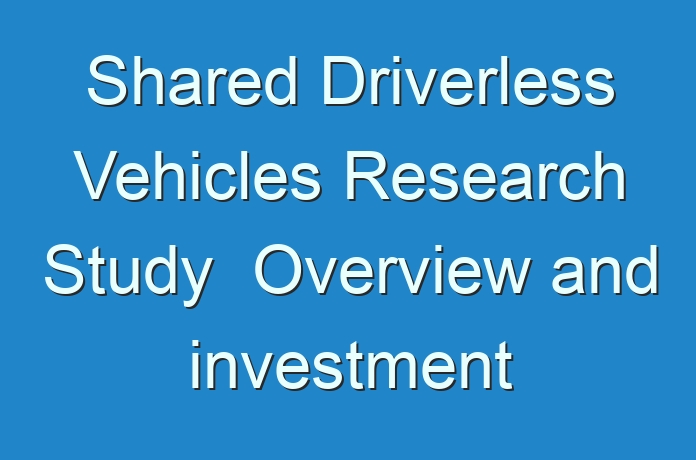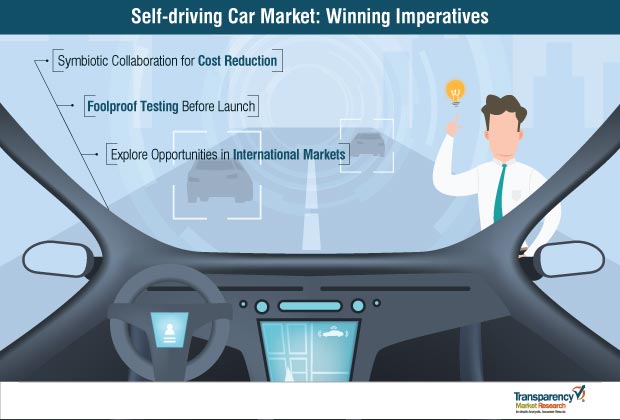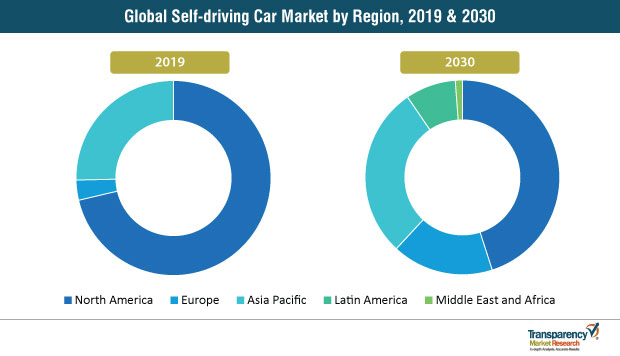
Self-driving Cars – The Elevated Future of Mobility
The race for a completely self-driving car is underway with increased ongoing testing and prototyping of self-driving cars taking place worldwide, and autonomous systems consistently becoming more advanced. The automotive industry is almost on the brink of entering into a new mobility ecosystem that could provide faster, cleaner, safer, cheaper, more efficient, and customized travel. However, this is just the tip of the iceberg, as below the surface, a massive restructuring of the automotive industry is underway, wherein, self-driving car companies are emerging as the key element in the strategies for future mobility.
While uncertainty abounds, specifically about the pace of transition, a fundamental shift is highly likely to drive a move away from driver-controlled vehicles toward a future mobility ecosystem that is centered around self-driving cars. As more and more automakers are experimenting and inventing in this direction, and have passionate voices that describe much-altered futures, Transparency Market Research (TMR), in its latest business intelligence, analyzed the opportunistic future prospects of this industry.
Purchase our Premium Research Report At:https://www.transparencymarketresearch.com/checkout.php?rep_id=70608<ype=S

Technological Roadmap of the Self-driving Car Market
The first self-driving car was prototyped in the 1980s by the Carnegie Mellon University, and since then, automakers and research universities, as well as the IT industry, have become increasingly interested in self-driving car technologies. Google began its self-driving car project in 2009, and soon after, autonomous vehicle laws were passed in Nevada. In 2012, Google tested its driverless project with a self-driving car fleet, including 6 Toyota Prius, 3 Lexus RX, and an Audi TT; while Tesla begun the development of its fully-autonomous car in 2013. It was in 2016 that Tesla introduced fully-autonomous hardware in all its new cars, followed by autonomous vehicle guidelines by the U.S. Department of Transportation in the same year.
The year 2018 marked the beginning of heavier investments in the self-driving car market, as Ford created a new AV division with plans to invest US$ 4 billion by 2024, and Uber ended its development of self-driving trucks to shift its focus on cars. The same year, the government of Japan announced plans to commence the testing of autonomous vehicles on public roads, with a vision to offer self-driving car services for the 2024 Tokyo Olympics. Since then, there has been no turning back for automakers in the self-driving car market. Though the self-driving car market is currently at a nascent stage, and gained US$ 20 Mn revenue in 2018, as per TMR, it holds high stakes of joining the mainstream in the years to come.
Get More Press Releases by TMR: https://www.prnewswire.com/news-releases/accepted-benefits-of-increased-vehicle-safety-improved-overall-on-the-road-quality-to-extend-copious-growth-opportunities-for-automotive-digital-key-market-growth-projected-at-outstanding-21-5-cagr-from-2021–2031–tmr-301313826.html
Impact of Undercurrents on the Self-driving Car Market
High Passenger Preference for Time-Saving Rides Unlocking Growth Prospects
Embedded with various sensors, including ultrasonic, LiDAR, RADAR, cameras, vision detectors, and GPS receivers, self-driving cars can drive closer together, and hold the potential to eliminate the probability of traffic congestion. This will create a parallel space for less traffic and reduced congestion, even with more cars on the road. The time-saving aspect of self-driving cars, as they allow passengers to utilize the time of the journey without any interference or menace of driving, is likely to fuel their adoption in the coming years.
To gauge the scope of customization in our reports, Ask for a Sample
Quest for Reliable Road Safety Solutions to Underpin Gains
Self-driving cars are coming out of laboratories and are undergoing test runs on the roads, and drawing increasing attention for their potential role in reducing fatal collisions. Self-driving car technology is increasingly shaping the current discussions of road safety. The International Organization for Road Accident Prevention estimates that, human error leads to ~ 90% of the road accidents, worldwide. For that matter, the adoption of self-driving cars can considerably reduce the number of road accidents, while making the streets safer by automating safety features and reducing dependency. This is a key determinant projected to propel the self-driving car market in the years to come. However, automakers still need to delve deeper into innovation to make self-driving cars widely adopted on a global scale.
Self-Driving Cars – Boon for People with Disabilities
The growing traction for better commuting sources for people with disability is anticipated to shape the adoption prospects of self-driving cars, as they could revolutionize how disabled people get around and travel even far from home. Visually-impaired people often face hurdles while travelling, and self-driving cars are poised to emerge as viable assistants to help them get around.
Favorable Regulations Underway
Reluctant regulatory bodies around the world are increasingly turning in favor of autonomous vehicles, in view of the potential role of self-driving cars in reducing the escalating number of road accidents taking place around the world. For instance, the Government of France is backing the development of self-driving cars with a vision to deploy ‘highly automated’ vehicles on public roads between 2024 and 2024. In 2019, the U.K. established a government department – the Centre for Connected and Autonomous Vehicles (CAV) – and has a legislation to allow testing on the motorways in the country, in the pipeline.

Want to know the obstructions to your company’s growth in future? Request a PDF sample here
Winning Strategies to Break Down the Barriers to Success
Symbiotic Collaborations for Cost Reduction
With automakers increasingly realizing the fact that the emergence of self-driving car technology will take longer than expected, they have placed focus on ways to reduce development costs and speed up schedules. Collaborations with automakers that are operating at different levels, and technology companies, are garnering center stage in the market, given the long-term commitment required to put self-driving cars on public roads. This falls in line with the fact that, the development costs of self-driving cars are high and the near-term returns are likely to be lower than expected.
Explore Opportunities in International Markets
Several companies in the self-driving car market are foraying into new regions where they have no existing operations or facilities, to expand their growth prospects and drive higher gains. For instance, U.S. auto supplier and autonomous software company, Aptivis, is opening an autonomous mobility center in China to emphasize development and subsequent deployment of its technology on public roads. Whereas, BMW and Tencent Holdings are collaborating to launch a computing center in China to develop self-driving cars in the world’s biggest auto market.
Competitive Landscape – Self-driving Car Market
- In 2019, Uber and Volvo joined hands to unveil the next-generation Volvo XC90 self-driving car, the first car fully autonomous self-driving car.
- In 2019, the U.K. established a government department – the Centre for Connected and Autonomous Vehicles (CAV) – and is working on legislations to allow testing on motorways in the country.
Contact us:
Transparency Market Research
State Tower,
90 State Street, Suite 700,
Albany NY – 12207,
United States
Tel: +1-518-618-1030 Email: sales@transparencymarketresearch.com
Website: https://www.transparencymarketresearch.com
https://todaysmarkettrends.wordpress.com





